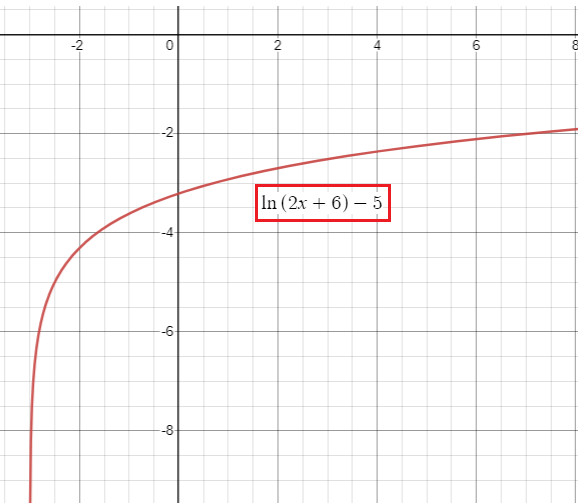FIND VERTICAL ASYMPTOTE AND END BEHAVIOR OF LOGARITHMIC
FUNCTION
Subscribe to our ▶️ YouTube channel 🔴 for the latest videos, updates, and tips.
Vertical asymptote :
Vertical asymptote is the vertical line which is very closer to to the curve.
To find the vertical asymptote, we have to equate the argument to 0 and solve for x.
End behaviour of the logarithmic function :
Discussing the outputs when x approaches ∞ and -∞ is called end behaviour of the function.

For the following exercise, state the domain, vertical asymptote, and end behaviour of the function.
Problem 1 :
f(x) = ln(2 - x)
Solution:
f(x) = ln(2 - x)
Domain:
2 - x > 0
-x > -2
x < 2
Domain: (-∞, 2)
Vertical asymptote:
2 - x = 0
-x = -2
x = 2
Vertical asymptote x = 2
End behaviour of function:
To identify end behaviour of the logarithmic function, let us have discussion about graph of the function.
f(x) = ln(2 - x)
f(x) = ln(-x + 2)
Since x is changed as -x, it should be reflection across y-axis and 2 units left horizontally.

From the graph above,
lim x->-∞ f(x) approaches ∞
and
lim x->2 f(x) approaches -∞
Problem 2 :
f(x) = log(x - 3/7)
Solution:
f(x) = log(x - 3/7)
Domain:
x - 3/7 > 0
x > 3/7
Domain: (3/7, ∞)
Vertical asymptote:
x - 3/7 = 0
x = 3/7
vertical asymptote x = 3/7

End behaviour of function:
To identify end behaviour of the logarithmic function, let us have discussion about graph of the function.
f(x) = log(x - 3/7)
No reflection, 3/7 units we have to move the graph to the right.
From the graph above,
lim x->∞ f(x) approaches ∞
and
lim x->3/7 f(x) approaches -∞
Problem 3 :
h(x) = -log(3x - 4) + 3
Solution:
h(x) = -log(3x - 4) + 3
Domain:
3x - 4 > 0
3x > 4
x > 4/3
Domain: (4/3, ∞)
Vertical asymptote:
3x - 4 = 0
3x = 4
x = 4/3
vertical asymptote x = 4/3
End behaviour of function:
To identify end behaviour of the logarithmic function, let us have discussion about graph of the function.
f(x) = -log(3x - 4) + 3
Reflection across x-axis, horizontal translation of 4/3 unit right and vertical translation of 3 units up.

From the graph above,
lim x->∞ f(x) approaches 0
and
lim x->4/3 f(x) approaches ∞
Problem 4 :
g(x) = ln(2x + 6) - 5
Solution:
g(x) = ln(2x + 6) - 5
Domain:
2x + 6 > 0
2x > -6
x > -3
Domain: (-3, ∞)
Vertical asymptote:
2x + 6 = 0
2x = -6
x = -3
vertical asymptote x = -3
End behaviour of function:
f(x) = ln(2x + 6) - 5
Reflection across x-axis, horizontal translation of 3 units left and vertical translation of 5 units down.

From the graph above,
lim x->∞ f(x) approaches ∞
and
lim x->-3 f(x) approaches -∞
Problem 5 :
f(x) = log3(15 - 5x) + 6
Solution:
f(x) = log3(15 - 5x) + 6
Domain:
15 - 5x > 0
15 > 5x
3 > x
x < 3
Domain: (-∞, 3)
Vertical asymptote:
15 - 5x = 0
15 = 5x
x = 3
vertical asymptote x = 3
End behaviour of function:
f(x) = log3(-5x + 15) + 6
or
f(x) = log3(-x + 3) + 6
Reflection across x-axis, horizontal translation of 3 units left and vertical translation of 6 units up.

From the graph above,
lim x->-∞ f(x) approaches ∞
and
lim x->3 f(x) approaches -∞
Subscribe to our ▶️ YouTube channel 🔴 for the latest videos, updates, and tips.
Recent Articles
-
Finding Range of Values Inequality Problems
May 21, 24 08:51 PM
Finding Range of Values Inequality Problems -
Solving Two Step Inequality Word Problems
May 21, 24 08:51 AM
Solving Two Step Inequality Word Problems -
Exponential Function Context and Data Modeling
May 20, 24 10:45 PM
Exponential Function Context and Data Modeling